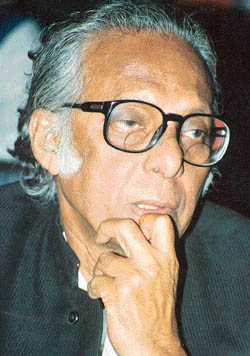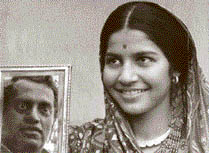The Dadasaheb Phalke Award hasn't come a day too soon to Mrinal Sen. The octogenarian Kolkata filmmaker is the 35th recipient of the coveted prize since its inception in 1970, but the honour should have been his at least a decade and a half ago.
 |
|
|
Sen crafted his finest films till the end of the 1980s, constructing a body of work indubitably on a par with, if not better than, anything that the luminaries who beat him to the Dadasaheb Phalke Award have produced. But better late than never.
Sen's eventful career has progressed only in fits and starts since the early 1990s, suggesting probably that the veteran director, who likes to describe himself as "a filmmaker by accident and writer by impulse", has attained creative fulfillment. He has made only three feature films in the past 15 years but he continues to write and hold forth as energetically as ever on varied aspects of the medium he has served with uncommon distinction. Only last year, he came out with his memoirs, Always Being Born.
It was in 1991 that Sen completed his 25th feature, Mahaprithibi. In the subsequent 13 years, he has added merely two more films to his oeuvre. Antareen and Aamaar Bhuban were separated in time by nine years for no apparent reason except the fact that Sen was a Member of Parliament from 1998 to 2003.
But it isn't just low productivity that is a worry. Admirers have detected a decline in the quality and vitality of his work. Despite being appealing in parts, none of the films he has made since the 1990s quite recaptured the sheer brilliance and power that this true master of the medium could once pack into his images and cinematic conceits.
His formidable reputation will, therefore, always rest on the subtly comic Bhuvan Shome (1969), the remarkably inventive Calcutta trilogy of the 1970s (Interview, Calcutta 71 and Padatik), the profoundly affecting "absence trilogy" (Ek Din Pratidin, Kharij and Ek Din Achanak), the superbly crafted Aakaler Sandhaney and the sparse but profoundly moving Khandahar. These nine films constitute only a third of his output of 27 features (Sen made several shorts and documentaries too), but they, along with the dramatic Mrigaya and the episodic, fairy tale-like chorus, are enough to place his work in a league of its own.
In an era in which Bollywood trash is being increasingly passed off as post-modern high art, the nation's highest cinema award for a filmmaker of Sen's ilk is indeed significant. He is the first director from the Indian cinema's non-mainstream sector since Satyajit Ray, who won in 1984, to be chosen for the Dadasaheb Phalke Award.
The other member of the globally acclaimed Bengal triumvirate, Ritwik Ghatak, of course, wasn't ever deemed worthy of the honour.
The award for Sen, no matter how belated, is the recognition of his contribution to a tradition of quality filmmaking just as it is an appreciation of the mastery that Ray, Ghatak and Sen, as a collective artistic force, achieved over their art and craft much before the advent of costly technology and an obsession with bottom lines yanked the soul out of our films.
Where exactly does Sen figure in the rarefied pantheon led by the revered Ray? If Ray was a classical artist to the core, even perhaps a romantic raconteur speaking a global language, and Ghatak an anguished flotsam of history articulating the pain of deracination, Sen's place in the annals of Bengali and Indian cinema is that of an angry agent provocateur, a rebel without a pause. But even at its most indignant and provocative, his cinema is tempered with wry humour and an ability to empathise with the materially dispossessed and morally or emotionally pressured.
Sen made his first feature, Raat Bhore, in 1953. It wasn't a debut that Sen was proud of, but the film did, in a tangential manner, bring into focus his concern with the rural-urban divide that cleaves the heart of the Indian society.
Sen's next film, Neel Aakasher Neeche (1958), which dealt with a bonding between a Chinese silk hawker and an urban Bengali housewife, set him on a collision course with the Establishment, inviting a two-month ban on the film. That wasn't surprising at all for a man with undisguised Leftist sympathies.
After tackling the theme of marriage in urban and semi-rural Bengal settings in films such as Baishey Shravan, a completely deromanticised portrayal of a man-woman relationship going to pieces in the face of the human instinct for self-preservation, and Punascha, Sen embarked upon the Calcutta trilogy that defined his early image as an iconoclast.
Disturbed by the social, political and economic turmoil mounting all around him, he parlayed his vision into films that flouted all rules of conventional Bengali cinema and carving out a new non-narrative way of seeing and communicating reality.
His career entered its most creative phase when he broke away from overtly polemical themes to explore the moral social foibles of the Bengali middle class.
In Ek Din Pratidin, the sole earning daughter of a family goes missing and all hell breaks loose. In Ek Din Achanak, one of the several Hindi films Sen has made, a respected academic turns his back on his family when his essential mediocrity is exposed. In Kharij, the death of a poor servant boy due to asphyxiation throws a middle class urban couple into complete moral confusion as they struggle to save their skins.
Sen's films have been constant probes into the labyrinths of a society where grinding poverty generates hopeless dehumanisation (witness his transportation of Munshi Premchand's searing Kafan in his only Telugu feature Oka Oorie Katha) or into the recesses of minds unable to communicate with each other (as in his reworking of a Saadat Hasan Manto story in Antareen, where two characters at opposite ends of the city make repeated conversations on the phone without ever meeting).
Blending satire with humanism, anger with sympathy, and the particular with the universal, he has given India – and the world – some of the most haunting films ever made.







comment:
p_commentcount